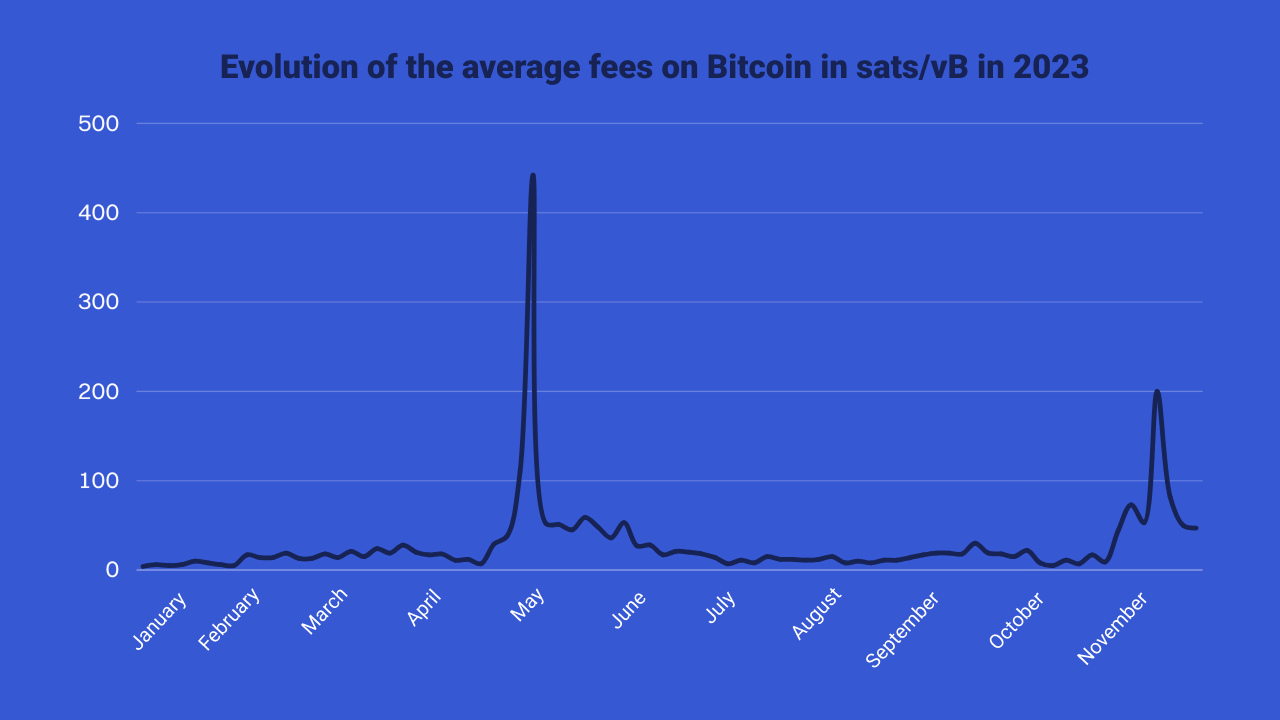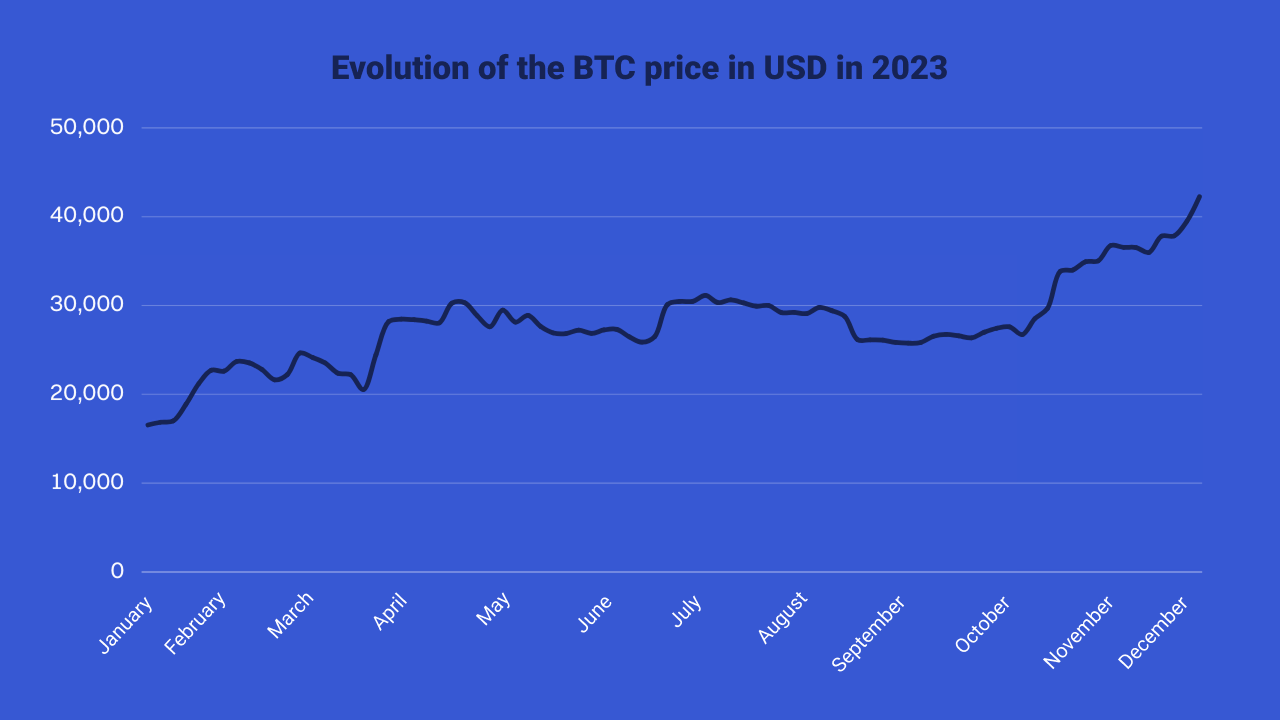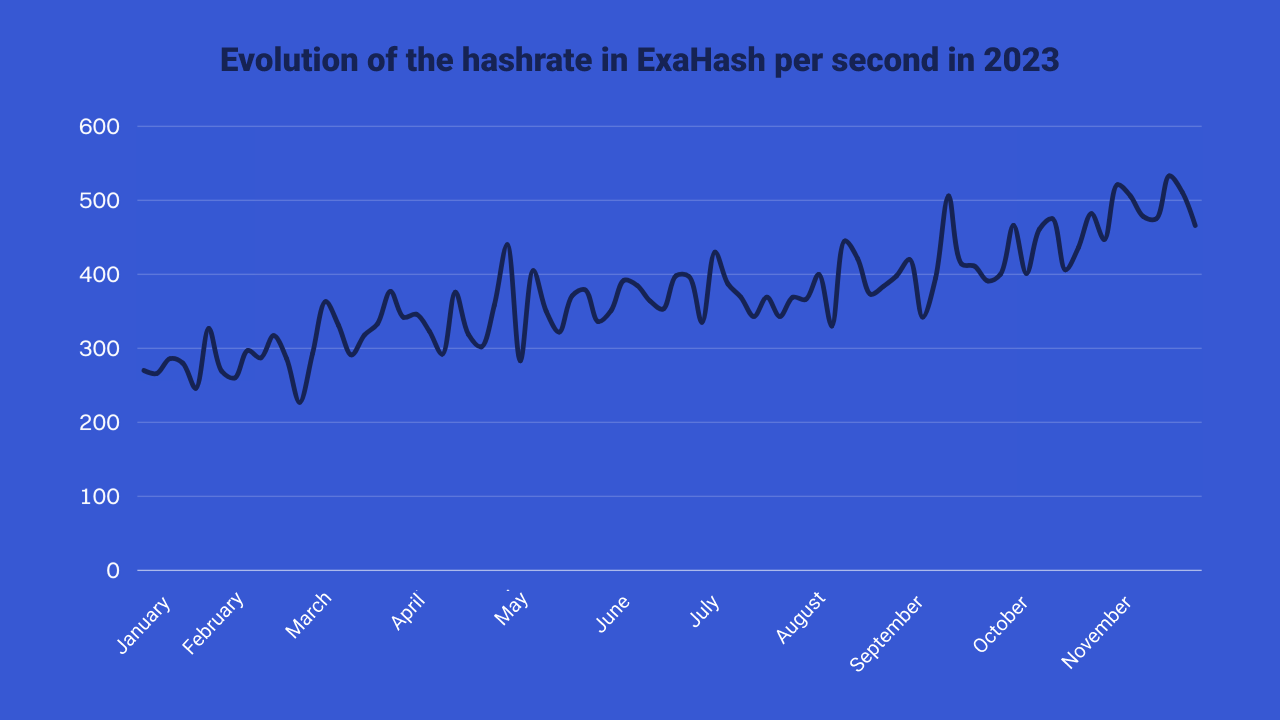Get started
Get started

Before fully moving on to the year 2024, we offer you a look back at 2023 which was rich in events for Bitcoin. It was a year brimming with technical innovations and political and financial news! At the end of the article, we will also analyze the main key figures of 2023 for Bitcoin and the trends for the coming year.
At the very beginning of this year 2023, the subject of Ordinals registrations created a real buzz. For the first time, we discovered a rather elegant way to attach various types of files to sats circulating on the network, thus paving the way for the creation of what could be similar to NFTs (non-fungible tokens) on the Bitcoin blockchain.
On January 20, 2023, Casey Rodarmor launched this new protocol using the space dedicated to transaction witnesses. Ordinals is designed to anchor what are called “Digital Artifacts,” which can be images, videos, or any other type of file, directly onto Bitcoin.
After its introduction, the Ordinals protocol saw increasing adoption. This rise in popularity coincided with a decline in the popularity of NFTs on other blockchains. Many saw the listings as an investment opportunity. As a result, the volume of Ordinals transactions has increased significantly on the Bitcoin network, even causing some saturation of the node mempools.
Some wanted to build on the momentum launched by Casey Rodarmor by trying to develop their own protocols. This is the example of Stamps, which, although it shares the concept of registering files in the manner of Ordinals, does so with much less elegance.
The meteoric rise of the Ordinals peaked in May 2023 with the emergence of BRC-20. This protocol, which is rather rudimentary, allows the creation of tokens attached to Bitcoin via Ordinals registrations. BRC-20 tokens quickly became the subject of uninhibited speculation, leading Bitcoin transaction fees to historic levels. This sudden increase in fees had consequences, especially on the Lightning network, where it became difficult to open or close channels during this period.

The madness around BRC-20 tokens has finally subsided, bringing fees on the Bitcoin blockchain back to more reasonable levels. Nevertheless, throughout 2023, the Ordinals were able to maintain a sustained interest among users.

February 9, 2023 marked the end of an era with the announcement of the cessation of activity of LocalBitcoins, a pioneer platform for peer-to-peer bitcoin exchanges. Founded in 2012, this institution, appreciated by bitcoiners from the beginning, has not been able to withstand the combined assaults of the Bear Market and increasingly demanding regulations. In particular, its model was crushed by the arrival of large cryptocurrency trading platforms.
The year 2023 was also marked by the communication campaign launched by the NGO Greenpeace, which criticizes the proof of work used on Bitcoin. Started in 2022 under the slogan” Change the code, not the climate ” (” Changing the code, not the climate ”), this initiative aims to replace the proof-of-work system considered too energy-intensive by a less energy-intensive alternative, such as the proof of stake. This campaign created an event at the beginning of 2023, when Greenpeace revealed a monumental sculpture of nearly 4 meters entitled “Skull Of Satoshi”.
.png)
This work by activist artist Benjamin Von Wong caused a strong reaction on Twitter, so much so that, in a fit of sarcasm, many bitcoiners adopted it as their profile photo.
Of course, such initiatives are often met with derision, as Bitcoin is not a centralized business, but rather a free peer-to-peer system. To make changes, beyond a marketing campaign, it is above all necessary to produce an alternative implementation of the protocol and try to push it within the community. And in fact, there is already an implementation of this type operating in Proof-of-Stake called” BitcoinPOS ”. This protocol, launched in 2020, uses Nakamoto's original code, but without proof of work.
Today, BitcoinPOS is dying. No more transactions are executed there and its total capitalization is only 42,000 dollars compared to almost 800 billion for Bitcoin. So it seems that the users have made their choice.
Obviously, Bitcoin and its proof-of-work mechanism are far from being a foregone conclusion for the environment. On the contrary, they could well be one of the answers to global warming.
➤ Discover why bitcoin is not an ecological disaster.
On a more technical level, 2023 could well be the year of Miniscript. To simply explain this concept to you, it is a kind of toolbox to provide a framework for programming complex scripts securely on Bitcoin.
Bitcoin's native language, called “Script”, is very complex to use, especially for sophisticated and customized applications. Above all, it is very difficult to check the limitations of a script. Miniscript addresses this by providing a subset of Script commands, making them much easier to design, analyze, and validate. Miniscript thus allows developers to build complex scripts in a safer and more reliable way.
Initially launched in 2018 by Peter Wuille, Andrew Poelstra and Sanket Kanjalkar, Miniscript was partially deployed on version 24.0.1 of Bitcoin Core, before being fully implemented with the release of version 25.0 last May. Beyond its integration with Core, Miniscript has also served as a basis for the development of new types of Bitcoin wallets, such as Liana, which offer the possibility of customizing UTXO spending conditions. Over the year, the adoption of Miniscript gradually expanded to hardware wallets.
The Miniscript project represents a significant advance in the field of self-custody. It will allow the personalization of Bitcoin wallets, thus reducing the risks of losing or stealing funds for users.
On May 20, 2023, on the occasion of The Bitcoin Conference In Miami, a young developer known under the alias Burak announces the arrival of a brand new second layer protocol called Ark. Like the Lightning Network, Ark is a system that operates on top of Bitcoin's main chain. It would make it possible to make fast, anonymous and inexpensive payments.
Unlike Lightning, the Ark protocol eliminates the need for inbound cash to receive payments, which is a huge step forward for the user experience. It provides a level of privacy comparable to that of coinjoin transactions, significantly surpassing Lightning's privacy model. In addition, with the implementation of covenants on Bitcoin, Ark could be non-interactive, allowing payments to be received without the constraint of maintaining a server 24 hours a day, like on Lightning.
Burak, the inventor of Ark, regularly has reservations about Lightning's ability to scale due to its dependence on the main chain. He suggests that, theoretically, Ark could integrate the entire world population on Bitcoin, and that, in autonomous custody.
.png)
While Ark can be thought of as a competitor to the Lightning Network, the two can actually coexist. They could even be quite complementary. However, it should be noted that at the moment, Ark is only a simple idea, as the underlying code has not yet been revealed by Burak. It will therefore be necessary to keep an eye on the evolution of this protocol, as it could well catalyze the massive adoption of Bitcoin, while relying on acceptable compromises.
Throughout the year, the suspense surrounding the creation of a spot Bitcoin ETF captured attention. On June 15, 2023, BlackRock, the asset management giant with more than $9 trillion under management, submitted a proposal to the SEC for the establishment of a Trust comparable to a spot Bitcoin ETF (spot). This event re-ignited momentum, encouraging other fund managers to follow suit. Companies such as WisdomTree, Valkyrie Investments, VanEck, Invesco, and BitWise, which had previously tried unsuccessfully to launch such a financial product, renewed their requests following the initiative of their competitor.
In July, the SEC agreed to review BlackRock's request. However, in September, the American authority postponed its decision on Bitcoin ETFs to January 2024. Another twist came on October 16, when Cointelegraph, a specialized crypto media, broadcast via X that the SEC had given the green light to BlackRock, causing the price of Bitcoin to soar. However, BlackRock quickly denied this announcement during the day.
The latest twist came on October 24 when DTCC, a compensation body for the NASDAQ stock exchange, briefly awarded the symbol IBTC to the BlackRock ETF. Some saw this listing as a sign of approval by the SEC. However, the DTCC removed the ETF from its list on the same day, before finally re-entering it the next day, each time causing fluctuations in the Bitcoin price. The conclusion of this saga now seems to have been postponed to 2024, when all eyes will be on the SEC's decision.
The second version of the data transport protocol between Bitcoin nodes, embodied by the BIP324, was merged on October 3 into the majority client Bitcoin Core. This integration is an important advance for those who operate Bitcoin nodes. It offers a new layer of encryption to secure the Bitcoin peer-to-peer network against certain attacks, in particular Man-In-The-Middle attacks. The BIP324 also promises to strengthen the confidentiality of Bitcoin nodes against eavesdropping, including those of Internet service providers, marking a major advance in protecting the privacy of users at the network level.
If all goes well, P2P V2 transport should be included as an option in version 26.0 of Bitcoin Core, which is scheduled to be deployed in the coming weeks.
➤ Understand the usefulness of a Bitcoin node.
This is surely the most surprising discovery of this year 2023 for Bitcoin. On October 9, Robin Linus introduced a brand new protocol called “BitVM”. This makes it possible to extend the functionalities of Bitcoin by giving it the possibility of verifying any calculation operation, without requiring a change in consensus.
The protocol consists in moving all calculations off the chain while allowing them to be contested if the other party claims a fraudulent result. To do this, BitVM exploits the universality of NAND logic gates which, when used in series, can reproduce any logic circuit. The idea is then to store the NAND calculation sequences in the form of sheets in the MAST of a Taproot output.
Although this protocol is still in the concept stage, it has demonstrated previously unsuspected prospects for Bitcoin.
Let's take a look at the essential data concerning Bitcoin for the year 2023 together. Let's start with the value of BTC, which has increased significantly during this time. On January 1, 2023, the year started with a price of $16,537. Although 2023 is not over yet, at the time of writing, the Bitcoin price is $42,260, which represents an increase of 156%.

It is not only the price of Bitcoin that has increased, but also its security. Indeed, the global network hash rate (hashrate) grew strongly, from 270 EH/s to 466 EH/s, which represents an increase of 72% over the year.

👉 Did you know that? An ExaHash (EH) corresponds to one trillion hashes, or 10^18.
The use of Bitcoin has also seen significant growth. From January to the end of November 2023, Bitcoin processed 136 million transactions, marking an increase of 46% compared to the year 2022, and that's not even including future data for the month of December. This impressive increase in trading volume was driven by over 45 million transactions associated with the Ordinals protocol.
If this trend continues, it is estimated that Bitcoin should have executed nearly 148 million transactions in total by 2023. What is certain is that the previous record of 120 million transactions, set in 2019, has already been surpassed.

The year 2024 still has many surprises in store for us for Bitcoin. On the technical side, while discussions around the Covenants have subsided at the end of the year, it is not impossible that we will attempt a new major soft fork, almost three years after the activation of Taproot. The most advanced proposals in this area are BIP118 (Sighash_AnyprevOut), BIP119 (OP_CheckTemplateVerify), and BIP345 (OP_Vault).
2024 will also be a halving year! Scheduled to take place around March or April, this event will cut the block reward in half, from 6.25 to 3.125 BTC. The monetary production on Bitcoin will therefore fall further. This halving brings with it its share of questions, in particular as to the ability of minors to survive following this sudden drop in the number of units that can be created, while the hash rate continued to increase in 2023. We will also monitor Bitcoin price fluctuations in response to the halving event, which has historically often been a sign of an uptrend in the market.
➤ Learn more about how Bitcoin Halving works.




